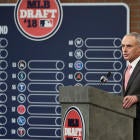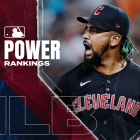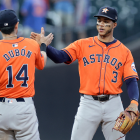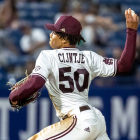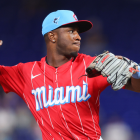The spread of the novel coronavirus has and will continue to impact all aspects of Major League Baseball's calendar year, beginning with Opening Day and extending to the postseason.
The amateur draft is an exception in only one regard: it is certain to happen following an agreement last week between the league and the Players Association. The draft will occur later (mid-to-late July) and feature fewer rounds (five-to-10 instead of 40) than normal. It will also involve a modified signing bonus schedule for those who are picked.
Still, the 2020 draft is going to happen, and it could have lasting ramifications across the board, according to various league sources who spoke to CBS Sports on the condition of anonymity. Let's break down the potential change across four levels.
What it means for scouts
The most immediate change will see amateur scouts get back to work.
Multiple sources confirmed to CBS Sports that beginning next week MLB is expected to permit scouts to resume contact with amateur players and their families and advisers. The league had banned such behavior back in mid-March as a means of preventing teams from gaining a competitive advantage during an uncertain time.
The news isn't all good on the scouting side. A permanently shorter draft could lead teams to consolidate areas, or the zones amateur scouts are assigned to cover. Additionally, a number of teams have issued notice to segments of their scouting departments that they could be furloughed come May. Pro scouts, who focus on the minors, figure to take the brunt of the hit. The fear is that those jobs will never return, and that teams will continue to cull their staffs.
Some had hoped that minimizing the draft's financial outlay would steel teams against layoffs or dismissals. "They may serve as means to a bigger-picture end for owners," one source said about the draft cost-saving initiatives, "but that's not top-of-mind for most people who work for clubs and wonder whether, or rather when, the hammer will drop."
What it means for the 2020-22 draft classes
Between the shortened draft, the altered compensation rules, and the NCAA's decision to permit seniors an extra year of eligibility, there's a good deal of potential volatility as it pertains to the talent levels of the next three draft classes.
"I'm most interested to see what happens with the tier of higher-profile high-school seniors who are committed to schools that are obviously more crowded after the NCAA's ruling," one scout said. "Do they opt for the JuCo route and try to re-enter what is an uncertain draft situation next year, or do some of them become more signable from our perspective?"
One source said they believed the rule changes will end up benefiting the 2022 and 2023 drafts the most, because this year's best high-school talent will go to college rather than leap into suboptimal conditions. Another thought the 2020-2021 classes could be loaded if unsure high-school players opt for junior college, which would make them draft eligible again next year.
"This draft being only five-to-10 rounds, the talent level will be high from start to finish," the source said. "I've only heard from one team who might still try to go the cheaper route and take advantage of the deferred bonuses."
What it means for minor-league teams
MLB's plan to shear the minor leagues by 42 teams was in motion prior to the pandemic, but every source agreed that the league appears to be leveraging the situation to get its desired outcome. "I absolutely believe MLB is going to use this as their excuse to go forward with their contraction plans," one talent evaluator said.
The logic goes like this: because there will be fewer players drafted the next two years, that means there doesn't need to be as many roster spots; and because there doesn't need to be as many roster spots, that means there doesn't need to be as many teams.
"I think we all know MLB's ultimate objective as it relates to this subject," a scout said, "and this is certainly an unfortunate manner in which they can claim plausible deniability, given the cash-flow considerations at play, while progressing their agenda on that front."
A pair of sources suggested that short-season clubs are the most at-risk.
"There will still be a need for major league depth and player development," an analyst said, "so I think the four full-season levels will continue to exist."
What it means for future labor talks
Perhaps the most intriguing aspect of the modified draft is what it means for CBA negotiations.
The Players Union has, in recent times, made concessions that harm tomorrow's players for the benefit of today's. The players have given teams amateur bonus pool limits, domestically and internationally, and hard-slotting, and now this gutted version of the draft, in which selected players will not receive the full extent of their signing bonuses for two full years afterward.
There's only so much more the players can bargain away from the future, and after they play those cards it's unclear how they'll gain leverage in future labor talks.
"This is just a generally f---ed-up situation that really puts a microscope on how not just owners but a lot of fans think," one scout said. "Everything is about major-league players, and little thought is given to the infrastructure that got them there."









